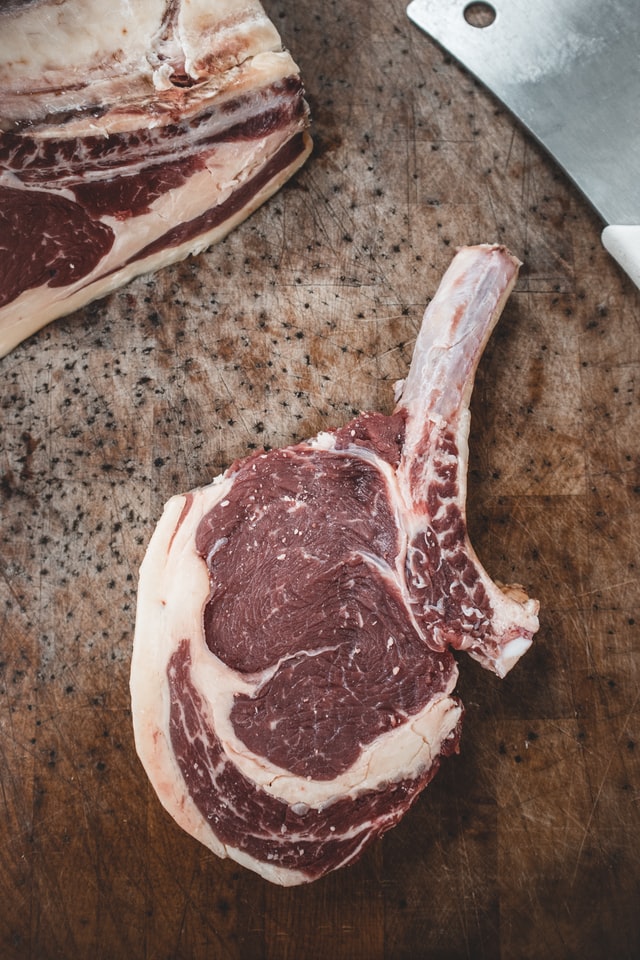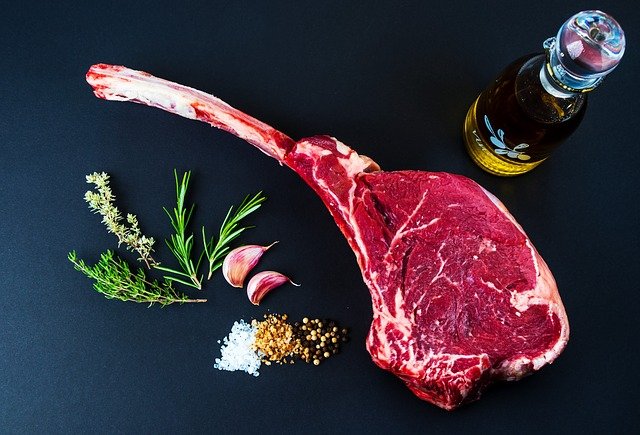Would you like to know how to serve delicious, perfectly cooked steak, time after time?
In this post, I shall let you into a few of the steak secrets I picked up whilst working in an award-winning Surrey kitchen…
In my opinion, Côte de Boeuf is about as good as steak gets.
It has all of the glorious marbled fats that you expect from a rib-eye and the unique flavour that you can only get from cooking meat on the bone.
Also, it has a cap of fat that renders down in the oven to a succulent basted finish, protecting the meat as it cooks.

During my time at the restaurant, I have seen many of my staff intimidated by this particular cut.
I think perhaps the combination of the French name and the cost of this product make this dish a little daunting to the more inexperienced chef.
However, if you follow these simple steps, you will be able to enjoy the award-winning Côte de Boeuf that we serve in our dining room from the comfort of your own home.
Source The Best Steak Available
Côte de Boeuf is an expensive cut. It is a cut for a special occasion.
However, when you consider that it is a cut that serves two people – not to mention the fact that you will be saving on those restaurant prices – I still think that it represents great value for money.
A reasonable size Côte de Boeuf will be around 30-40z and 2-3 inches thick.
My personal favourite is the grass-fed Aberdeen Angus. I have eaten steak the world over and have yet to find a better flavour.
Check with your butcher that the meat has been dry-aged for at least 28 days and, while you’re there, ask him to French-trim the rib.
(It makes no difference to the flavour, but it looks wonderfully impressive when you present your stunning centrepiece – after all, we eat with our eyes first!)
Season Early
There is a bit of myth repeated in kitchens the world over; ‘salting meat too early will dry it out!’.
It is certainly true that salt draws moisture to the meat’s surface, but this is actually a benefit (if you know what you are doing).
I crumble a little sea salt onto the Côte de Boeuf around 20 minutes before I intend to start cooking. This salt acts as a catalyst to draw the natural sugars and proteins to the surface of the meat.

When the steak hits the hot pan, these sugars and proteins melt into the salt, butter, and oil, helping to form a delicious crust on the meat. Ironically, this crust will actually seal the Côte de Boeuf and help it retain moisture during cooking.
Try it once and I guarantee you’ll never look back!
“Make Sure That The Steak Is Room Temperature Before Cooking”
A lifetime ago, as a young and naïve chef, I recall raising my eyes as I saw my Head Chef taking a steak from the fridge and putting it straight into the pan.
As a ‘reward’ for my constructive criticism, I spent the rest of the afternoon with a thermometer and thick sirloin steak.
After nearly two hours, its core temperature had risen by about 5°C. Given that a medium-rare steak is served at around 65°C, I think he made his point.
Like the salting myth, the ‘room temperature’ canard is something that is best consigned to the kitchen bin.
I would recommend simply patting the surface of the meat down with a kitchen towel and leaving it uncovered and salted in the fridge before cooking.
The Cooking Process
So – the main event.
You should, by now, have a great quality, aged, dry, French-trimmed, and salted Côte de Boeuf sitting in the fridge.
You will be very pleased to hear that the cooking is actually the easy part!
Start by preheating your oven to 220°C or gas mark 7.
Rub the meat all over with good quality olive oil, a liberal twist of cracked pepper, and a little more sea salt. This combination helps form that impressive crust on the beef when it hits the pan.
I prefer to use a heavy cast-iron pan for cooking my Côte de Boeuf. The pan must be screeching hot before you start cooking. If you pour a little olive oil onto the surface of the pan and it starts smoking – it’s ready!

Place the beef in the pan and gently press down for a moment or two. As it sizzles, start to spoon the hot oil and cooking juices onto the exposed side of the meat. Continue to baste for three minutes and then check the underside of the beef. It should have a lovely, dark sear on the surface – the way it would look when presented on the plate.
Next, turn the meat over in the pan and tip away any excess cooking oil.
Then add two or three large knobs of butter and baste the other side for another three minutes. The butter should be brown and foaming as you spoon it over the beef.
Now – For Our Individual Touches.
Over the years, I have tried many ingredients to complement my Côte de Boeuf’s cooking, and I have concluded that, with a cut of this quality, less is always more.
Alongside the meat, I simply add three or four unpeeled cloves of smoked garlic, a sprig of rosemary, and some freshly picked thyme.
After that, I put the whole pan into the centre of the preheated oven.

Steak Cooking Timings
I know, better than most, that everyone likes their meat cooked differently.
My personal preference is to enjoy steak medium rare – and luckily for a shared Côte de Boeuf, my other half agrees!
If you like your meat rare then leave the pan in the oven for 15 minutes, medium-rare 20 minutes, and medium 25 minutes.
Remember, there is no shame in investing in a meat thermometer. Not everyone will be cooking five or six of these ribs a night and it would be a disaster if the odd extra minute ruined the beef.
On the medium to rare occasion that other people cook for me, they have used a meat thermometer and I am always impressed with the results (if not a little put out that it seems to be just as effective as my many years of experience!)
Once removed from the oven, cover the beef in tin foil and leave it to rest on a board for 10 minutes. This allows the meat to reabsorb the juices.
(Everybody prefers the juices in the beef rather than left on the plate!)
Sides And Accoutrements
A perfectly cooked Côte de Boeuf will always steal the show.
For that reason, I choose to serve mine with a simple crisp garden salad and hand-cut chips.
There are almost as many other sides to accompany the dish as there will be people reading this. I have seen truffle fries, onion rings, hasselback potatoes, roast peppers, and myriad other accoutrements over the years.
To be honest, now that you have the blueprint for cooking the best steak you’ll ever eat – I’ll leave the rest (and the resting) to you!

